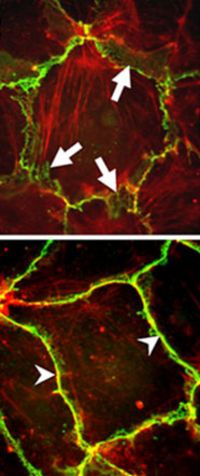
Mechanical stimulation of the endothelium, which is generated by blood flow and periodic blood pressure ("shear stress", "stretch") plays a decisive role in the biology of the endothelium. Mechanical stimulation activates numerous signal paths and modulates the morphology, the function and the pattern of gene expression of cells. While laminar, unidirectional flows have a protective effect on cells, turbulent flows are thought to be responsible for the development of arteriosclerosis. The effect of shear stress on the endothelial barrier function has until now received little scientific attention because the experimental setups are lacking. In our working group, we have connected a cone-plate rheometer system ("BTF-System") to an impedance spectroscopic data analysis system, which allows us to determine with high validity and reliability the cross-endothelial electrical resistance under "shear stress". We are able to show that shear stress will raise the paracellular barrier function within minutes. This effect correlates to the reorganisation of proteins at contact points between cells,which requires activation of the small GTPase. During the following hours, the cells become elongated and align themselves to the direction of the flow, as typically found in arteries. The elongation of the cells leads to an increase to the cellular circumference, which is compensated for by the expression of additional proteins, such as VE-Cadherin, Catenin, and PECAM-1, at the cellular contact points. Currently, we are investigating the fundamental molecular mechanisms which underlie these cellular reactions.Mechanical stimulation of the endothelium, which is generated by blood flow and periodic blood pressure ("shear stress"

